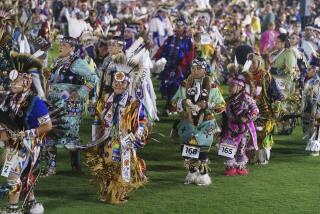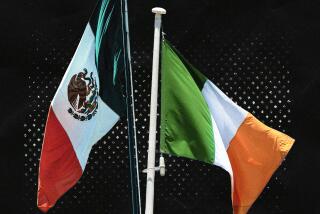Operation Geronimo dishonors the Indian leader
“Geronimo—ekia.” With this coded message, sent on May 1, a U.S. Navy SEALs commando squad signaled the death of Osama bin Laden, the “enemy killed in action.” The mission was pulled off without a hitch, but in the week since then, debate has raged in some circles about the code name.
The administration hasn’t explained why the operation targeting Bin Laden used the name of one of the nation’s best-known Native Americans, saying the selection process of names for such missions is confidential. But the use of Geronimo’s name speaks to the powerful, if unexamined, hold that the nation’s “Indian wars” continue to have on our popular consciousness.
Geronimo, whose real name was Guyaalé, “the Yawner,” was
a member of the Chiricahua Apache, a group that ranged across New Mexico, Arizona and northern Mexico from the 1820s to the 1880s. His relations with the U.S. were not always hostile. Indeed, as he later reported in his autobiography, his first encounter with government representatives — a small team marking the U.S.-Mexico border in the 1850s — was cordial. “[W]e made a treaty with them by shaking hands and promising to be brothers,” recalled Geronimo. “Then we made our camp near their camp, and they came to trade with us.
But after a misunderstanding led to the U.S. Army’s attempt to arrest the Chiricahua leader Cochise in 1861, relations between the Chiricahua Apaches and the government deteriorated. On four separate occasions, Geronimo fled the reservations on which the U.S. government had tried to confine him. The Apache leader and the men, women and children accompanying him successfully eluded the Army for long periods, supporting themselves with raids on settlements in Arizona and across the border in Mexico. Geronimo’s final surrender in 1886 is generally seen as the end of the “Indian wars,” giving Geronimo the distinction of being the last Indian to hold out against the U.S. militarily.
Present-day Native American leaders have rightly objected to the implied comparison between Geronimo and Bin Laden. As Jeff Houser, chairman of the Fort Sill Apache Tribe noted in a letter to President Obama, “to equate Geronimo … with Osama bin Laden, a mass murderer and cowardly terrorist, is painful and offensive to our tribe and to all native Americans.” No religious fundamentalist, Geronimo never sought to create an all-encompassing caliphate. Rather, he simply wanted to be left alone.
Indian peoples have long played an odd role in American popular culture, seen at once as primitives who are dangerously savage but also authentic, brave and connected to nature. In U.S. military culture, this view has led to Indians being seen as the embodiment of warrior culture. U.S. paratroopers, after watching the 1939 movie “Geronimo,” (a film advertised at the time as featuring images of “war-maddened savages terrorizing the West”), began shouting the Apache leader’s name as they jumped from airplanes to bolster their courage. The military has often used Indian names for its helicopters (Kiowa, Cheyenne, Comanche, Blackhawk and, yes, Apache). And now, there is this latest use of Geronimo.
The appropriation of Indian labels is particularly unseemly given the reality of today’s military. Native Americans have one of the highest per capita enlistment rates in the military of any ethnic group. Powwows often begin with the entering of an honor guard, composed of military veterans who carry the U.S. and tribal flags. At the San Carlos Apache Reservation in Arizona, where Geronimo was confined in the 1870s and ‘80s, the tribal government maintains a billboard proudly listing all the San Carlos Apaches serving in the military.
It’s no wonder that Indian peoples feel their sacrifices have been dishonored by the labeling of our worst enemy as Geronimo and that they themselves have been treated as other than real Americans. As Guyaalé’s great-grandson, Joseph Geronimo, noted recently, using the name in the operation to kill Bin Laden was a “slap in the face.” His ancestor, after all, “was more American than anybody else.”
But more than its misguided comparison of two individuals, the whole episode reminds us that we do not yet fully grasp our Native American past. If Americans know so little about Geronimo, probably the most famous Indian in American history, how many know anything at all about some of Geronimo’s contemporaries, who laid the groundwork for the Indian rights movement? How many have ever heard, say, of Carlos Montezuma, the Yavapai with a medical degree from Northwestern, who in 1911 founded the first Indian rights organization, the Society of American Indians? Or Sarah Winnemucca, who wrote an autobiography about her Paiute heritage and became an early advocate on behalf of Indian peoples?
Beyond reckoning with its Native American past, the U.S. needs to think about its Native American present and future too. Despite the fabled wealth of a few Native American communities from the recent rise of casino gambling, most of Indian country remains desperately impoverished. The unemployment rate on Geronimo’s onetime home of San Carlos, for example, is today close to 70%. Imagine if Operation Geronimo, rather than a mission to seize a terrorist in distant Pakistan, had been instead a U.S. effort to address the endemic poverty that haunts many Indian reservations today. Would that not have represented a long-overdue American victory as well?
Karl Jacoby is a professor of history at Brown University and the author of “Shadows at Dawn: A Borderlands Massacre and the Violence of History.”
Karl Jacoby is a professor of history at Brown University and the author of “Shadows at Dawn: A Borderlands Massacre and the Violence of History.”
More to Read
A cure for the common opinion
Get thought-provoking perspectives with our weekly newsletter.
You may occasionally receive promotional content from the Los Angeles Times.










